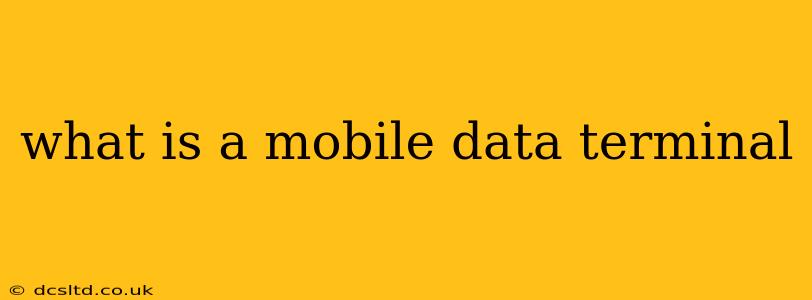A Mobile Data Terminal (MDT) is a device that allows users to access and transmit data while on the move. Think of it as a mobile office, enabling communication and data exchange regardless of location. Unlike simple mobile phones, MDTs are typically designed for more robust data handling, often incorporating features like GPS tracking, specialized software, and connections to various communication networks. This makes them essential tools in many industries.
What are the different types of Mobile Data Terminals?
The market offers a diverse range of MDTs, each tailored to specific applications. Categorization depends largely on their functionalities and deployment methods:
- Vehicle-mounted MDTs: These are frequently seen in transportation and logistics, integrating seamlessly into vehicles such as trucks, ambulances, and police cars. They provide real-time tracking, dispatch communication, and other essential functions.
- Handheld MDTs: These portable devices resemble ruggedized tablets or smartphones, offering flexibility for field workers in various sectors like delivery services, utilities maintenance, and fieldwork.
- Fixed-location MDTs: While the term "mobile" might seem contradictory, these devices are situated at fixed points but still function as data terminals within a mobile network, often used for monitoring and remote control. Think of them as permanently placed but wirelessly connected.
What are the key features of a Mobile Data Terminal?
Several key features distinguish MDTs from ordinary mobile devices:
- Ruggedized Design: Many MDTs are built to withstand harsh environmental conditions, including extreme temperatures, vibrations, and drops.
- GPS Integration: Most MDTs incorporate GPS functionality for precise location tracking, crucial for fleet management, emergency services, and field operations.
- Connectivity Options: MDTs support various communication protocols, including cellular (4G/5G), satellite, and Wi-Fi, ensuring reliable data transmission even in remote areas.
- Specialized Software: Often, MDTs come with pre-installed or customizable software for specific applications, such as route optimization, dispatch management, or data collection.
- Data Security: Given the sensitive nature of the data they handle, robust security measures are often integrated to protect information from unauthorized access.
What industries use Mobile Data Terminals?
The applications of MDTs are vast and span numerous sectors:
- Transportation and Logistics: Fleet tracking, delivery management, and driver communication.
- Emergency Services: Dispatch coordination, location tracking, and real-time information sharing.
- Field Service: Work order management, remote diagnostics, and data collection.
- Utilities: Infrastructure monitoring, meter reading, and maintenance scheduling.
- Law Enforcement: Real-time crime reporting, officer tracking, and evidence management.
What are the benefits of using a Mobile Data Terminal?
Implementing MDTs offers numerous advantages:
- Improved Efficiency: Streamlined workflows and real-time data access enhance operational efficiency.
- Enhanced Communication: Real-time communication between teams and central dispatch improves response times and coordination.
- Better Decision-Making: Access to real-time data empowers informed decision-making.
- Increased Safety: Real-time location tracking and communication enhance worker safety.
- Reduced Costs: Improved efficiency and reduced operational overhead can lead to significant cost savings.
How does a Mobile Data Terminal work?
MDTs function by receiving and transmitting data through various communication networks. This typically involves:
- Data Acquisition: Collecting data from sensors, GPS receivers, or user input.
- Data Transmission: Sending data through a chosen communication network (cellular, satellite, etc.).
- Data Processing: Processing and formatting data for use in applications or storage.
- Data Storage: Storing data locally or on a remote server.
- Data Display: Presenting data on the MDT's screen for user interaction.
What is the difference between a Mobile Data Terminal and a PDA?
While both MDTs and Personal Digital Assistants (PDAs) offer mobile computing capabilities, MDTs are typically designed for more robust data handling, often within specific industries, prioritizing features like ruggedness, specialized software, and seamless integration with communication networks. PDAs, while offering similar basic functionality, generally lack the specialized hardware and software found in MDTs. The key difference lies in their intended application and the level of robustness required.
This comprehensive guide provides a solid understanding of mobile data terminals, their functionalities, applications, and benefits. The rapidly evolving technology landscape continues to refine MDTs, leading to even greater efficiency and integration across various industries.
